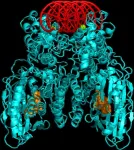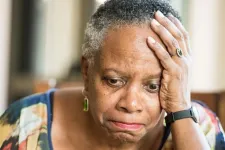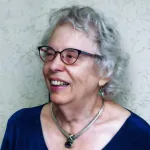(Press-News.org) As interest in wearable technology has surged, research into creating energy-storage devices that can be woven into textiles has also increased. Researchers at North Carolina State University have now identified a “sweet spot” at which the length of a threadlike energy storage technology called a “yarn-shaped supercapacitor” (YSC) yields the highest and most efficient flow of energy per unit length.
“When it comes to the length of the YSC, it’s a tradeoff between power and energy,” said Wei Gao, corresponding author of a paper on the work and an associate professor of textile engineering, chemistry and science at NC State. “It’s not only about how much energy you can store, but also the internal resistance we care about.”
Specifically, the researchers found that YSCs in the 40-60 centimeter range provided the best overall energy output.
Previous research on YSCs has delivered varied and sometimes conflicting results when it comes to length-dependent energy output. The aim of the new study, Gao said, was to provide a consistent, comprehensive model to explain changes in YSC performance across a wide range of lengths.
To do this, researchers first fabricated several YSCs using pairs of activated carbon-incorporated electrode yarns and a gel electrolyte. Nylon threads were wrapped around each yarn to prevent shorting, and then the two electrodes were plied together and coated further with the same gel electrolyte. Researchers created these YSCs in segments ranging from 10 to 300 cm long, and then ran electrical currents of varying frequencies through them. This allowed them to measure two characteristics; internal resistance, which measures how much electrical current is impeded while trying to move through a battery, and capacitance, which is the ability to store electrical energy.
The researchers found that capacitance generally increased linearly with length between 10 and 60 cm, after which gains in capacitance slowed significantly as length increased. The results were also influenced by the frequency of the electricity – or the rate at which the electrical current oscillates. Depending on the electrical frequency of the current, the YSCs would see diminishing gains in capacitance up to the 300 cm in length, though some plateaued at around 150 cm. Mathematical models also showed that YSCs between 40-80 cm exhibited the lowest internal resistance, which led researchers to determine that 40-60 cm was the most efficient length overall.
Lead author Nanfei He, a postdoctoral research scholar at NC State, said the study is part of a larger effort aimed at creating YSCs that can be integrated into clothing.
“Identifying the optimal length of YSCs is critical for their effective utilization, guiding the development of strategies for seamless integration into fabrics,” He said.
Funding for the study came from the U.S. Army Research Office, and Gao said she imagines early applications for YSCs will be mainly military-focused.
“Imagine you can make a yarn, just a regular textile yarn, that you also make into a battery,” Gao said. “You can basically hide it in your clothing. If you can do that, you can add so many more functions to your clothing.”
More work needs to be done before YSCs become viable for practical applications.
“The technology is not mature yet, and that’s why there is so much funding and so much interest in developing it,” Gao said. “We can make yarn batteries, but can we make them durable, reliable, and safe? Can we make them washable? If you’re going to put it on your body, there are so many other challenges besides its energy-storage functions. Right now we’re focused on the reliability aspect, making sure that if you twist and move the yarn around it will still work. That plus safety are the main issues, and I think once we achieve those two it will broaden the scope of their applications by a lot.”
The paper, “Modeling of yarn-shaped supercapacitors – Unraveling its length dependent output,” is published in Journal of Power Sources. The paper was co-authored by Nanfei He, a postdoctoral researcher at NC State, Xi Zhang, a researcher with the Yancheng Institute of Technology, and Junhua Song and Feng Zhao of Storagenergy Technologies, Inc.
The work was done with support from the U.S. Army Research Office under grant W911NF19C0074 and W911NF18C0086.
-Pitchford-
Note to editors: The paper abstract follows.
“Modeling of yarn-shaped supercapacitors – Unraveling its length dependent output”
Authors: Nanfei He and Wei Gao, NC State University, Xi Zhang, Yancheng Institute of Technology, and Junhua Song and Feng Zhao, Storagenergy Technologies, Inc.
Published: Jan. 17, 2024 in Journal of Power Sources
DOI: 10.1016/j.jpowsour.2024.234067
Abstract: Yarn-shaped energy-storage devices are promising power sources for electronic textiles, since they carry the possibility to be seamlessly integrated into various fabrics. The energy/power outputs of these devices are inevitably a function of their lengths, the dependence on which is yet to be thoroughly explored. Despite numerous research on yarn-shaped supercapacitors (YSCs) and batteries, the correlation between yarn length and their electrochemical output remains ambiguous, and sometimes even controversial. Herein, a dual transmission-line model for YSCs is created and used to fit the electrochemical impedance spectra (EIS) of YSCs ranging from 10 cm to 300 cm in length. The evolution of equivalent series resistances, electrolyte diffusion resistances and capacitances of YSCs as yarn length increases is investigated. Given the structure and components of YSCs used in this study, a favorable length range of 40–60 cm has been identified to achieve the best electrochemical performance, including the lowest internal resistance and the highest specific capacitance, where the highest energy and power densities sit. The mathematical model introduced in this work provides a reasonable description of the electrochemical behaviors of YSCs in different yarn lengths, offering a theoretical foundation to guide the design of these devices for specific application scenarios.
END
New York, NY (February 6, 2024)—Researchers at the Icahn School of Medicine at Mount Sinai have identified a new approach to controlling bacterial infections. The findings were described in the February 6 online issue of Nature Structural & Molecular Biology [DOI # 10.1038/s41594-024-01220-x].
The team found a way to turn on a vital bacterial defense mechanism to fight and manage bacterial infections. The defense system, called cyclic oligonucleotide-based antiphage signaling system (CBASS), is a natural mechanism ...
Using the Nutrition Facts labels to make food choices is significantly associated with healthy eating among eighth and 11th grade students in Texas, although the proportion of students using nutrition labels to make their food choices is low, according to research from UTHealth Houston.
A study led by first author Christopher D. Pfledderer, PhD, MPH, assistant professor in the Department of Health Promotion and Behavioral Sciences at UTHealth Houston School of Public Health, and senior author Deanna Hoelscher, PhD, RDN, the John P. McGovern Professor in Health Promotion and regional dean of the ...
AMHERST, Mass. – A team of researchers from the University of Massachusetts Amherst recently published a pioneering study that answers a central question in biology: how do organisms rally a wide range of cellular processes when they encounter a change—either internally or in the external environment—to thrive in good times or survive the bad times? The research, focused on plants and published in Cell, identifies the interactions between four compounds: pectin, receptor proteins FERONIA and LLG1 and the signal RALF peptide. In particular, the team discovered that a molecular condensation process, called liquid-liquid phase separation, that ...
New findings led by researchers at the American Cancer Society (ACS) and the National Cancer Institute (NCI) show more than one-third of cancer patients had a major adverse financial event – bankruptcy, lien, or eviction – before their cancer diagnosis. These patients with adverse financial events (AFEs) had a later-stage diagnosis compared with patients with no events. The findings are published today in the Journal of Clinical Oncology (JCO).
“Patients with a previous AFE not only face greater likelihood of more advanced cancer but also may encounter substantial barriers to receiving recommended care ...
PHILADELPHIA (February 6, 2024) – A groundbreaking study from the University of Pennsylvania School of Nursing (Penn Nursing), recently published in Innovation in Aging, has shown promising results in improving the quality of life (QOL) and sleep quality in individuals living with memory problems. The research delves into the efficacy of a nonpharmacological approach in a trial known as the Healthy Patterns Sleep Program.
Nancy Hodgson, PhD, RN, FAAN, the Claire M. Fagin Leadership Professor in Nursing and Chair of Department of Biobehavioral Health ...
The Oceanography Society (TOS) congratulates Emeritus Professor Mitsuo Uematsu on his selection as a Fellow. The citation for this honor recognizes his pioneering research on long-range atmospheric transport of Asian dust across the Pacific Ocean and its impact on marine biogeochemistry.
The nomination materials noted that Dr Uematsu’s research is of the highest quality and notable for its interdisciplinarity and international leadership, as well as its pioneering and continuing nature. These contributions are exemplified through his service on several international scientific committees such as Future Earth and the Executive ...
The Oceanography Society (TOS) congratulates Claudia Benitez-Nelson on her selection as a Fellow. The citation on her certificate recognizes her outstanding contributions to understanding marine biogeochemical cycling and her exceptional commitment to mentoring and increasing diversity in ocean sciences.
The nomination materials noted that Dr. Benitez-Nelson is “one of the leading oceanographers of her generation…the world leader in the global phosphorus cycle, the use of isotopes (thorium) for quantifying export processes, and how carbon is transformed as it flows from coastal systems ...
The Oceanography Society (TOS) congratulates the Rutgers University Center for Ocean Observing Leadership (RUCOOL) team on its selection as the recipient of the TOS Ocean Observing Team Award. This award recognizes innovation and excellence in sustained ocean observing for scientific and practical applications. The citation on the team’s certificate recognizes RUCOOL for transforming oceanography by sharing their pioneering sampling platforms, sensing methods, and their integration in models and education.
Rutgers University’s Center of Ocean Observing Leadership has ...
The Oceanography Society (TOS) congratulates Phillip R. Taylor for being named a Fellow. The citation on Dr. Taylor’s certificate recognizes him for the “expansion and diversification of the ocean sciences at national and international levels and for building cooperative interactions among agencies and scientific fields.”
Dr. Taylor’s nomination noted his “singular strength was a willingness to work with agency partners (within and outside of NSF) and science community leaders to develop novel programs that attracted additional investment, ...
The Oceanography Society (TOS) congratulates Susan B. Cook on her selection as a Fellow. The citation recognizes her for pivotal contributions toward expanding and strengthening ocean programs in higher education and for documenting and promoting the involvement of women and underrepresented groups in ocean science.
Dr. Cook’s contributions to the ocean sciences community extend well beyond her impactful service to The Oceanography Society, where she held the position of Secretary from 2007 to 2018. As one example, she expanded the focus of ocean education to the national level, first playing a pivotal role as an original ...










